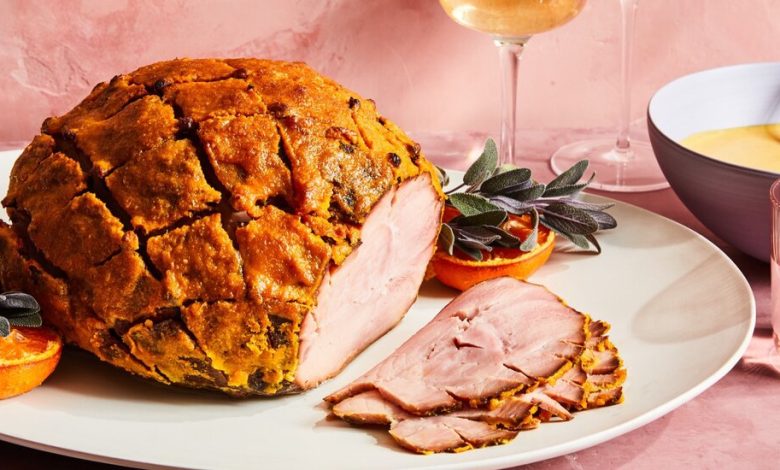Add a Little Zing to Your Classic Christmas Ham

“Who invented Christmas?” my sons asked a couple of years ago. They were piling shortbread cookies onto a plate and filling a glass with milk to welcome and fuel Santa. Crackers lay waiting for the next day, ready to be pulled apart with a bang. Vegetables were peeled and sliced, a ham was studded with cloves. Taking in these traditions entirely foreign to me until I married an Irishman and we made our own family, I found it a very good question indeed.
Who did “invent” Christmas? Well, for our little family, it was my husband, Karl. Our Christmas is basically his: a collection of the customs he grew up with (including an adult who would secretly knock the cookies and spill the milk as “clumsy” Santa does). Some have been let go, others adapted, still others adhered to absolutely. They’re rules, really, respected and reinvented.
Recipe: Christmas Glazed Ham
It’s not just Karl, though. Who else “invented” Christmas? Could we say Charles Dickens, maybe, whose book “A Christmas Carol” is credited with creating an image that lives on with the “traditional” holiday of today. Of course, the December date was marked for a long time before the Victorians. Constantine, the first Christian Roman emperor, back in the fourth century, likely rooted for the occasion as a way to weaken pagan traditions. It wasn’t until the publication of Dickens’s moralistic tale in 1843, though, that Christmas became associated with charity and family, feasting and gifting.
So, we have Karl and Dickens. We have a fourth-century emperor. What about Santa? Who “invented” him? Was it the scholar Clement Clarke Moore? His (though debates about authorship continue) “An Account of a Visit From St. Nicholas,” first published in 1823, went a long way to solidifying the image of a portly, jolly Santa that still holds today. Is it Santa or St. Nicholas? Or Father Christmas or Kris Kringle? Was he a third-century monk from Asia Minor, believed to have walked the earth to become the patron saint of children, or a character from a fairy tale with a great big beard and an even bigger tummy?
I was thinking about who “invented” Christmas when my team and I were creating this “new” recipe for ham. We knew we wanted a baked ham, a tradition that reaches right back to the late Middle Ages, when a boar’s head took pride of place on the Christmas table, but we also wanted to ring the changes. We wanted to keep the cloves, the most festive of spices, and a sticky glazed skin. So far, so traditional.
But the spark of inspiration came from Katja Tausig of the test-kitchen team, who in turn was inspired by the cookbook author Claudia Roden. It was Roden’s treatment of a whole orange in an orange-and-almond Sephardic Passover cake — cooking it down to blitz it up before adding the whole thing to the batter — that Tausig wanted to play around with. It worked.
So, who “invented” this ham? Was it Tausig? Or Roden? Or the woman in 1960 who moved from Aleppo, Syria, to Egypt and first gave Roden the recipe? The cake, Roden discovered, was neither Syrian nor Egyptian but originally from Andalusia. And so on and so forth it goes. No one person or place “invented” the cake. Or this ham. Or, indeed, Christmas.
Recipes, as with traditions, are a combination of things. On one hand, they’re a set of reassuring rules and routines: Do this, then do that and the outcome will be just so. On the other hand, there’s that space in all recipes for reimagination and re-creation.
Rather than betraying the original, I like to think that reinvention lets these traditions live on. All the stories, people and places along the way should be credited and remembered. Rather than trying to pin down a singular answer of invention, maybe we should all be asking who “inspired” something? It’s as true for excited kids the night before Christmas as it is for grown-ups making the traditions that will be adopted — and adapted — as the years roll by.
Recipe: Christmas Glazed Ham



